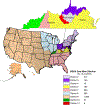Respirable coal mine dust in underground mines, United States, 1982-2017
- PMID: 31033017
- PMCID: PMC6800046
- DOI: 10.1002/ajim.22974
Respirable coal mine dust in underground mines, United States, 1982-2017
Abstract
Background: This study summarized the mass concentration and quartz mass percent of respirable coal mine dust samples (annually, by district, and by occupation) from underground coal mines during 1982-2017.
Methods: Respirable dust and quartz data collected and analyzed by Mine Safety and Health Administration (MSHA) were summarized by year, coal mining occupation, and geographical area. The older (before August 2016) 2.0 mg/m 3 respirable dust MSHA permissible exposure limit (PEL) was used across all years for comparative purposes. For respirable dust and quartz, geometric mean and percent of samples exceeding the respirable dust PEL (2.0 mg/m 3 or a reduced standard for samples with >5% quartz content) were calculated. For quartz samples, the average percent quartz content was also calculated.
Results: The overall geometric mean concentration for 681 497 respirable dust samples was 0.55 mg/m 3 and 5.5% of the samples exceeded the 2.0 mg/m 3 PEL. The overall respirable quartz geometric mean concentration for 210 944 samples was 0.038 mg/m 3 and 18.7% of these samples exceeded the applicable standard. There was a decline over time in the percent of respirable dust samples exceeding 2.0 mg/m 3 . The respirable dust geometric mean concentration was lower in central Appalachia compared to the rest of the United States. However, the respirable quartz geometric mean concentration and the mean percent quartz content were higher in central Appalachia.
Conclusion: This study summarizes respirable dust and quartz concentrations from coal mine inspector samples and may provide an insight into differences in the prevalence of pneumoconiosis by region and occupation.
Keywords: MSHA; MSHA Districts; coal mine dust; occupational groups; quartz.
© 2019 Wiley Periodicals, Inc.
Conflict of interest statement
CONFLICT OF INTERESTS
The authors declare that there are no conflict of interests.
DISCLOSURE BY AJIM EDITOR OF RECORD
John Meyer declares that he has no conflict of interest in the review and publication decision regarding this article.
Figures




References
-
- Federal Coal Mine Health and Safety Act of 1969, in Pub. L. No. 91–173, S. 2917. 1969. http://www.msha.gov/SOLICITOR/COALACT/69act.htm, Accessed August 6, 2018.
-
- Federal Mine Safety and Health Act of 1977, in Pub. L. No. 91–173, as amended by Pub. L. 95–164. 1977. https://arlweb.msha.gov/REGS/ACT/ACTTC.HTM, Accessed November 26, 2018.
-
- MSHA fact sheet. https://arlweb.msha.gov/endblacklung/docs/factsheet.pdf, Accessed September 24, 2018.
-
- National Institute for Occupational Safety and Health (NIOSH). Criteria for a recommended standard: Occupational exposure to respirable coal mine dust, DHHS (NIOSH) Pub. No. 95–106. Cincinnati, OH: NIOSH, 1995. https://www.cdc.gov/niosh/docs/95-106/pdfs/95-106.pdf, Accessed April 4, 2018.
MeSH terms
Substances
Grants and funding
LinkOut - more resources
Full Text Sources
Medical

